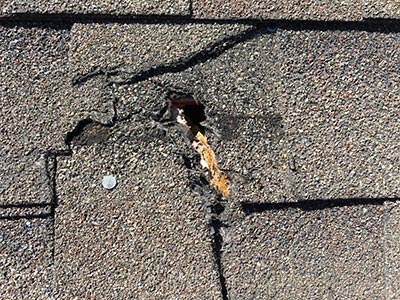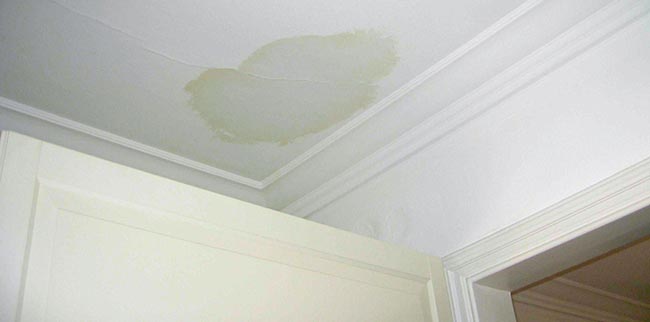It’s Spring in Colorado and it’s been lightly raining all day. You’re home from a long day’s work in the kitchen making yourself something to eat when you notice the ocassional water drip coming from the hood vent above the stove. You don’t think much of it, maybe it’s just condensation. You forget about it and get back to enjoying your evening. Days or weeks later the next rain storms comes around and you notice that once ocassional drip is now a steady drip and water is getting all over your range and you’re panicking wondering what to do.
What you should have done when you first noticed that occasional drip was not ignore it, but call a roofer to see if your roof was leaking. Had you dealt with that small drip, it could have been a quick, inexpensive roof repair. Now, you have a bigger, costlier problem. This is why you shouldn’t delay fixing that small roof leak.
This is a common scenario. Homeowners notice a small, seemingly insignificant problem and ignore it, hoping it will go away. What you should do is, as soon as you can, get into your attic and/or roof and see if you notice any obvious problems. It’s best if you can get into your attic while it’s raining, this way, you might be able to see where the rain is entering into your attic, or follow it to that entry point. If you are unable or uncomfortable getting in your attic or on your roof, contact someone who can. When professional roofing companies such as ours offer free roof inspections and consultations, you have nothing to loose.

Common Problems That Lead to a Leaking Roof Include
- Hole in your Roof
- Curled Asphalt Shingles
- Cracked Roofing Materials
- Missing Roof Material
- Exposed Nails
- Lifted Fasteners
- Unsealed Roofing Materials
- Damaged Vent Boots
- Mold on Exterior Walls
- Damaged Flashing
- Rusted Flashing
- Unsealed Flashing
When conducting your annual roof inspection, keep an eye open for signs your roof could be leaking, such as holes in your roof, curled or cracked shingles, missing roof material, exposed nails, lifted nails or screws, unsealed roof materials, or damaged roof materials. A hole in your roof is a sure sign your roof is leaking. You’ll want to get this patched right away. With curled shingles, the seal between shingles is broken and this can lead to a leaking roof. Shingles curl as a result of inadequate attic/roof ventilation. Shingles crack due to exposure to extreme temperature fluxuations. If you notice excessive cracked shingles, this could result in your roof leaking. Get your roof inspected soon.
Missing roof material, such as asphalt shingles or sheet metal is often the result of high winds. This is fairly common in Northern Colorado. If your roof is missing any material, replace them as soon as you can. Any delay could result in a roof leak. Exposed nails is a sign the roof wasn’t installed correctly or missing roof material. If you notice exposed nails, cover them as soon as you can with construction sealant. If you notice any lifted fasteners, such as nails or screws, drive them back down and seal them.
Unsealed roofing materials, such as shingles or flashing, should be resealed right away. Otherwise, you could have a roof leak come the next rain storm. Use construction sealant to reseal any roof material. If you notice any damaged flashing, replace it at once, or contact your favorite roofing company. Remember, no roof repair job is too big or too small for us. You shouldn’t delay fixing that small roof leak because if it’s caught soon enough, you can save yourself a lot of headache and money.
Common Signs Your Roof is Actively Leaking Include
- Stains on Your Ceiling or Wall
- Mold on Exterior Wall
- Mold in Your Attic
- Drips from Light Fixtures
- Drips from Bathroom Vents

If you notice a stain developing on your ceiling, you probably have a leaking roof. When drywall absorbs water, it turns a yellow-ish color. Rain passing through your roof and into an exterior wall can lead to mold growing on that wall. If you see mold on an exterior wall, get that roof inspected at once. Once repaired, clean-up the mold and paint the area with Kilz. Kilz will stop the spread of the mold. Mold in your attic is another sign you probably have a roof leak. It also could be inadequate attic ventilation. Regardless, a professional roofing company can help. If you notice mold in your attic contact us for a free roof inspection.
If during a rain storm, you notice water dripping from a vent or light fixture, your roof is currently leaking and should you get it repaired as soon as the rain stops. Otherwise, the damage the water leak is causing could grow into a much larger, more costly problem. If you can get into your attic while it’s raining, you might be able to see where the water is coming-in from. However, you might not.
The Bottom Line
You shouldn’t delay fixing that small roof leak because it can grow into a big expensive problem. If a small roof leak is caught soon enough, you might be looking at a small roof repair or patch. If ignored, you might be looking at drywall repair and repainting or worse. There are electrical lines and boxes in your attic. If water comes in contact them, you could have an electrical short and/or fire.
